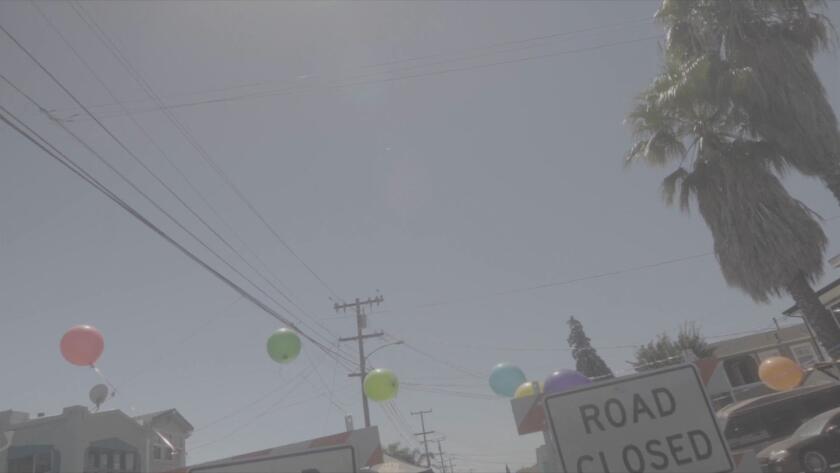Shocked by Oakland’s decline, a resident seeks to revive one block at a time
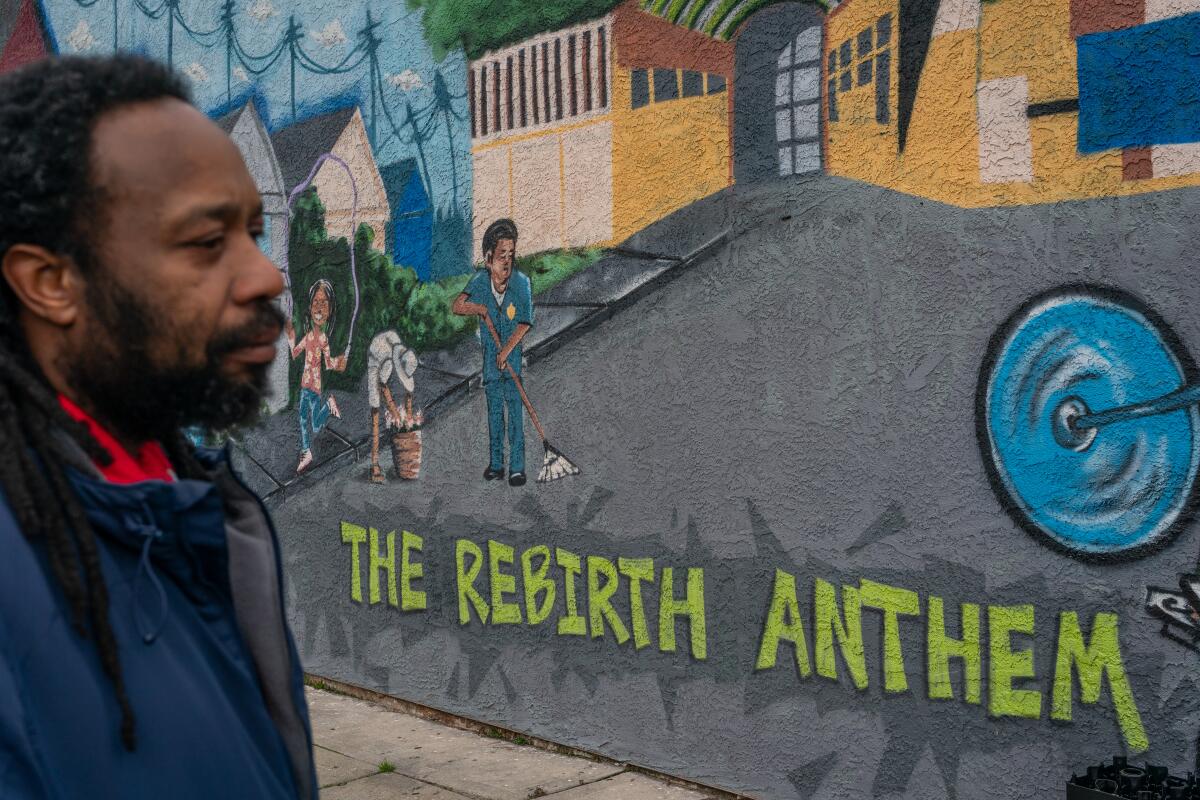
- Share via
Obad Qoashasha stands behind a plastic barrier at the cash register of the Handy Corner Market in East Oakland, helping a steady stream of customers with their purchases.
Customers come to the market on the corner of Scoville Street and 57th Avenue for snacks, a drink or a mop — the market has a little bit of everything.
In the four years Qoashasha has been the market’s manager, he said, there’s been a shift in the community — a noticeable effort to keep the business and the surrounding area clean and safe.
- Share via
Keisha Henderson, an East Oakland native, brought in community organizations and local government to clean up a street in the city’s 6th district.
Scoville Street, a two-block stretch between 55th and 57th Avenues, is surrounded by signs of deterioration and indifference. Streets are littered with trash, cars are double-parked or left on sidewalks, greenery is sparse, and businesses along the area’s commercial corridor, International Boulevard, are often covered with graffiti.
More broadly, all of East Oakland is reckoning with persistent crime that’s pushing small businesses and franchise operators to shutter, leaving communities with scant options. The malaise is plain for all to see.
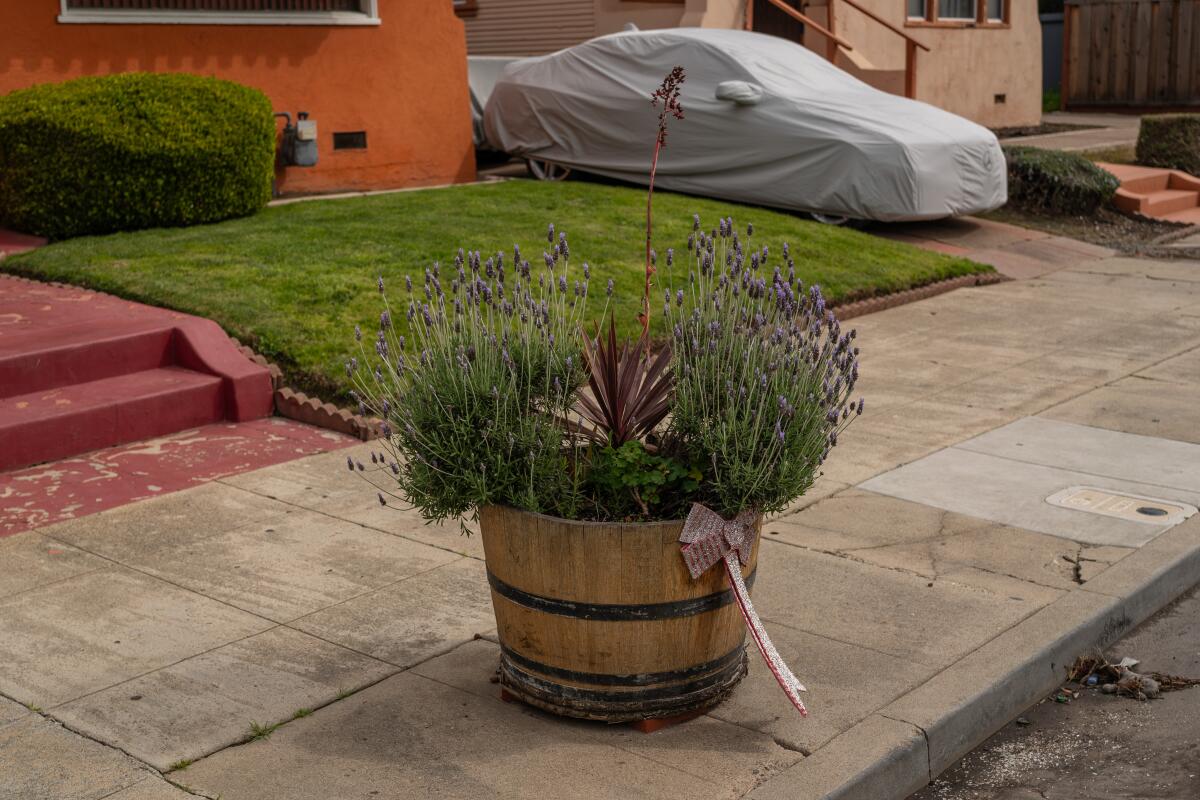
The Scoville block is different. There are no signs of blight. The street is free of trash, the houses are neat and maintained. The sidewalks are dotted by planters filled with blooming succulents.
Instead of graffiti, the wall of the Handy Corner Market sports a mural by local artist Derrick Shavers, titled “The Rebirth Anthem.” Intended to embody Scoville’s spirit, it shows kids popping wheelies on their bikes, a father cutting his son’s hair and a resident tending plants against the backdrop of the block’s homes and Rainbow Recreation Center.
Notably, the mural and two others that are visible when the market’s security gate is brought down at night have been left untouched since they were painted in 2021, Qoashasha said.
There are still some blemishes, and no one would mistake this working-class neighborhood for Pacific Palisades. But residents on the block say they feel much safer than they did just a few years ago.
Qoashasha credits that difference to an East Oakland homeowner named Keisha Henderson, whose persistent demands for action brought nonprofit organizations, local government and residents together to restore the area and make this block a model she wants to eventually replicate throughout the city.
In an interview, Henderson said she wanted a better environment for people to raise their families in. But at its heart, she said, her mission was about bringing back the community’s sense of pride in their home, in Oakland.
Taking back Scoville Street
Born and raised in Oakland, Henderson left in 2010 to attend college in Southern California, but returned every few months to visit. Although she could tell the community was changing, it wasn’t until she moved back permanently in 2017 to be with her terminally ill mother and grandfather that she noticed that, as she put it, “the city is not a place that I fully recognize.”
When she moved back to the area , neighbors catalogued its problems. Strangers used their driveways for drug dealing. Street lamps and personal floodlights were routinely shot out. People defecated on the sidewalk or in yards. Gunfire erupted at the church on one end of the block. Petty gamblers held dice games on the sidewalk. And vandals would spray paint derogatory messages on the Handy Corner Market’s wall, turning it into a slander message board.
Residents on the block didn’t feel safe enough to sit on their porches or let their kids play outside.

“They told me that there were people that lived on the block who foreclosed on their house on purpose just to get away,” Henderson said.
One of her neighbors, 21-year-old Marielos Carmona, was embroiled in a dispute at the time with another neighbor, who blocked her driveway and let their dogs loose in Carmona’s yard. The dispute escalated to the point that Carmona was assaulted, Henderson said.
This sort of harassment, combined with the rampant drug activity on the street, led to a constant stream of renters coming and going on Scoville Street, she said. That turnover prevented the neighborhood from coalescing into a community.
“When the neighbors told me all this, I was not having it,” she said.
Henderson knew that if just one homeowner stepped in with improvements, that wouldn’t be enough to inspire change throughout the neighborhood. She had to get the rest of the block on board.
She said some neighbors hesitated to join in for fear of retaliation from drug dealers and vandals, but Henderson told them, “If we’re going to take a risk, we all have to take it together.”
Re-envisioning Scoville Street
Henderson’s vision for transforming the block started with beautification.
If property owners wouldn’t clean up their lots, Henderson got the city’s code enforcement office involved, making reports on wildly overgrown vegetation, trash, and abandoned or broken-down cars.
Henderson filed 36 complaints on the block between 2019 and 2022, and all reported code issues have been abated, said Sean Maher, communications director for the city of Oakland.

If there was illicit activity happening on the block, she would call the Oakland Police Department, which she felt hadn’t enforced the law in the neighborhood consistently.
Henderson made connections with workers in both departments, sharing the block’s information and residents’ concerns, inviting them to neighborhood events and keeping an open line of communication.
Carmona, a Scoville resident, said Henderson helped her reach out to the police department and stuck with her through the process of obtaining a restraining order.
“I’m living happier and safer,” she said.
She’s not alone on that score. Carmona said she sees more people walking their dogs outside, kids playing outside and residents decorating their homes for the holidays — an idea that Henderson suggested last year.
The working relationship with city agencies was made possible, Henderson said, because residents kept up their end of the bargain by cleaning up the block, putting effort into beautification, and getting familiar with how the city departments could help them.
City employees were also becoming a part of the community by attending Scoville Street events, like Henderson’s pop-up cleanup efforts and discussions.
Wrapping in community partners
Henderson also needed to raise money to support her beautification push. That meant finding and tapping partners in the nonprofit world.
One of the first was the Civic Design Studio, the brainchild of Thomas Wong of Oakland. Wong was frustrated that all the creativity, energy and imagination high school students exuded in their projects would never leave the campus. So Civic Design Studio works with high schools, universities, local artists and industry professionals to create public displays and large-scale projects in the city of Oakland and other parts of the Bay Area.
“Our work doesn’t exist unless there’s people on the ground who are willing to take ownership of projects and leadership to see it through so that it’s not just sustainable but regenerative for the community,” Wong said.
Henderson met Wong when his organization was working with Fremont High School’s carpentry and architecture program to create 100 planters. After hearing that she wanted more plants and greenery to attract pollinating insects and birds, Fremont students provided 60 of the planters through Wong’s group to Scoville Street with the promise that the neighbors and the corner market would maintain them.
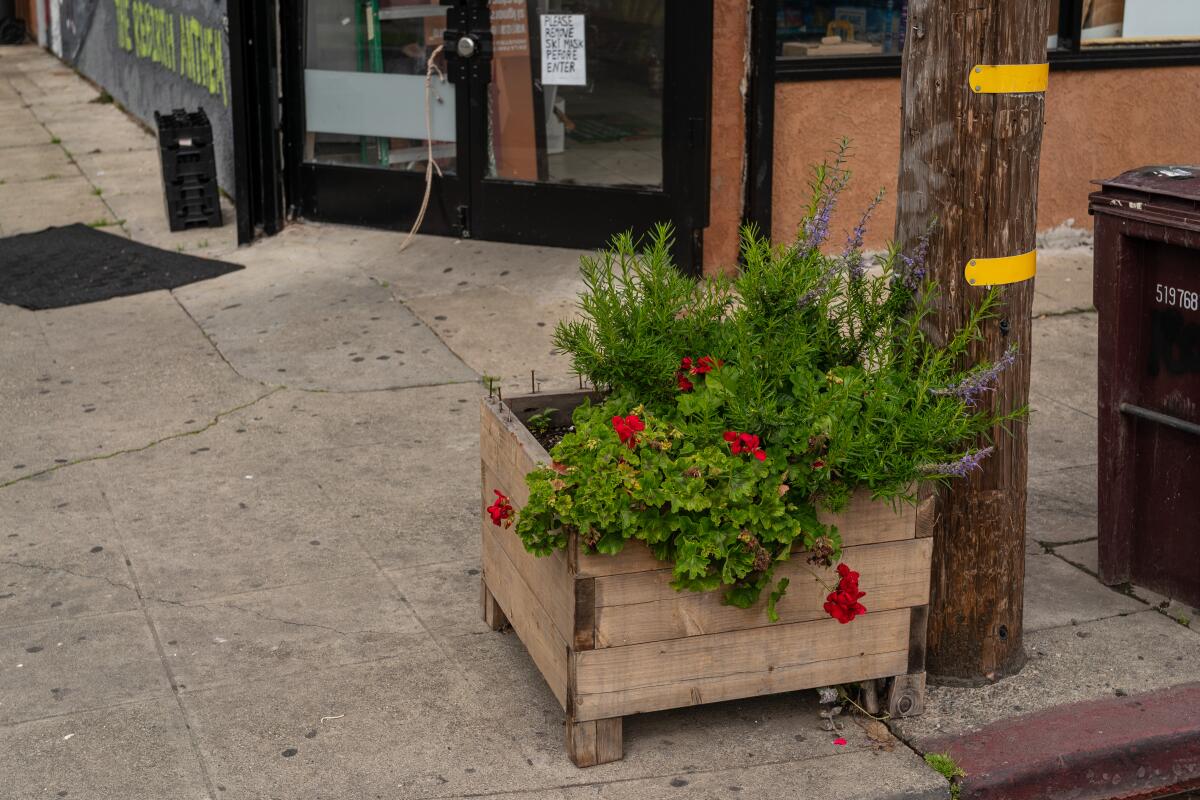
Wong said the project was a win-win: Students get to see their project serving the public a mere one-mile walk from the school campus, and Scoville Street residents see a tangible investment in the beautification of their block.
“It’s an area that created itself without a lot of money, major grants or anything like that,” he said of Scoville Street. “It was just utilizing the social fabric and the cultural fabric of the neighborhood to make it happen.”
A $2,000 grant from the East Bay Asian Local Development Corp funded the barrels and technical assistance with the project.
“The thing is, government is never funded enough for all of its needs, and they’re met with a lot of restrictions,” said Annie Ledbury, the associate director of creative community development for the East Bay Asian Local Development Corp. That’s where organizations like hers come in, providing communities with resources — funding, connections, expertise — to help them create safer, more livable communities that are more tightly bound together.
The nonprofit East Bay Asian Local Development Corp. promotes healthy and safe communities through social and financial services and affordable housing. One of the organization’s neighborhood collaboratives, Healthy Haven’s Court, worked with Henderson to develop a plan for Scoville Street, funding portions of her project including the beautification efforts.
“She’s is a very tenacious citizen and she is committed to tracking down and finding resources and bringing them into her community,” Ledbury said. “That is admirable and it is not your average citizen.”
A good example of that tenacity is Henderson’s year-long push to get trees planted on the block. Local organizations turned her down, saying they didn’t have the funds and feared that the trees’ upkeep would fall back to them.
“I told them that I am not taking ‘no’ for an answer, but we can negotiate,” she said.
She eventually met Arthur Boone from Trees for Oakland, who believed in her vision. His organization donated five trees to Scoville.
Boone got the city permits and visited the block every other month for a year after the trees were planted to make sure they were being taken care of, Henderson said.
The community celebrated all of this work with a pop-up event on July 23, 2022, shutting down the street so children could play, neighbors could plant flowers and succulents in their new planter barrels, and Shavers could could paint a new permanent mural on the pavement.
Replicating the Rebirth Anthem
A few decades before Henderson began her work on Scoville Street, a project she dubs “The Rebirth Anthem,” a different group of advocates tried to clean up the neighborhood.
Ken Bowers moved to the block in 1982 when he was 33 years old. He recalls people playing loud music from their car stereos into the night, dealing drugs and showing “general disrespect for the neighborhood.”
To get rid of the disruption on the block, Bowers organized Scoville Neighbors, a small group that meet regularly for several years and had a connection with their council member, who helped get the city’s attention.
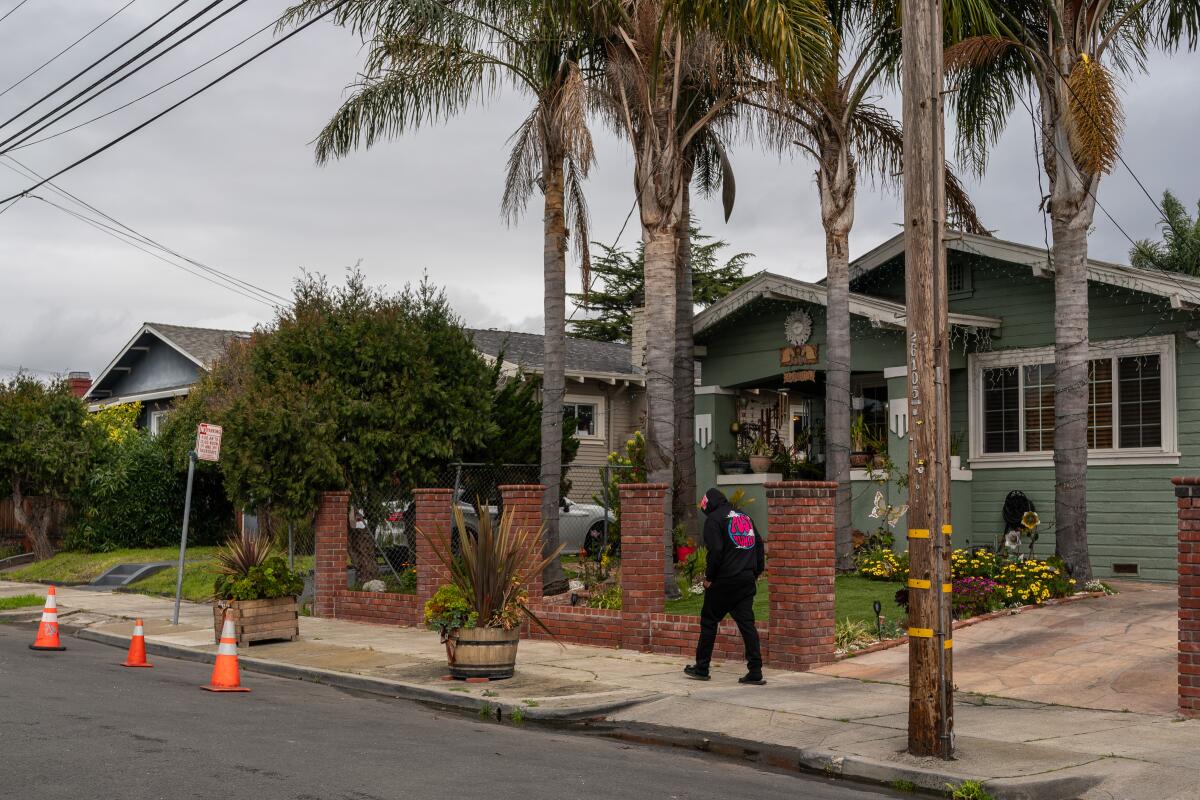
As part of Bowers’ efforts, he drafted a resolution that the City Council passed in 1999 called “block building” to encourage joint efforts by the city and local residents to eliminate blight from neighborhoods.
But Scoville Neighbors lost steam, so Bowers was pleased when Henderson reached out to all the neighbors and started cleaning up the block once more.
It’s still not perfect — there are still “some rough edges in the neighborhood and sometimes the city is unresponsive,” Bowers said — but Henderson has “earned her stripes.”
What she did takes a lot of leg work, he said, as well as determination.
“Wanting improvement and wanting pride, you can’t force that on anybody, but that needs to be there,” Bowers said. “And when it’s there, leaders will emerge, and what we’ve done here can be replicated.”
More to Read
Sign up for Essential California
The most important California stories and recommendations in your inbox every morning.
You may occasionally receive promotional content from the Los Angeles Times.

